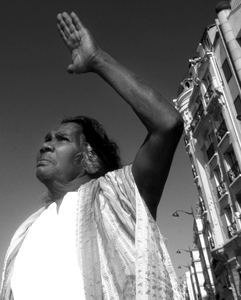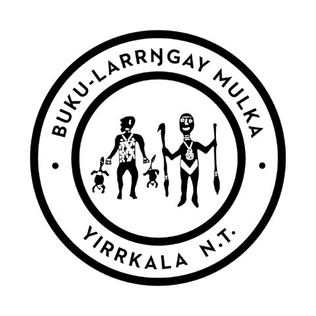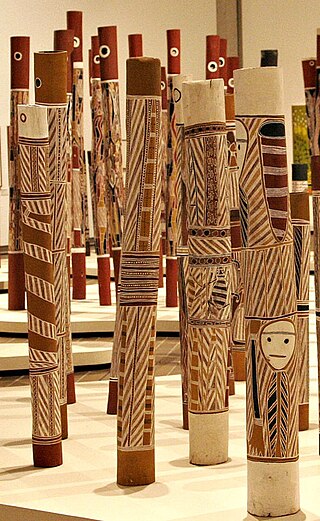Related Research Articles

Yirrkala is a small community in East Arnhem Region, Northern Territory, Australia, 18 kilometres (11 mi) southeast of the large mining town of Nhulunbuy, on the Gove Peninsula in Arnhem Land.
Wandjuk Djuwakan Marika OBE, was an Aboriginal Australian painter, actor, composer and Indigenous land rights activist. He was a member of the Rirratjingu clan of the Yolngu people of north-east Arnhem Land in the Northern Territory of Australia, and the son of Mawalan 1 Marika.

Gulumbu Yunupingu, after her death known as Djotarra or Ms Yunupingu, was an Australian Aboriginal artist and women's leader from the Yolngu people of Arnhem Land, in the Northern Territory of Australia.
Narritjin Maymuru was a Yolngu people artist and activist noted for Bark painting. He began painting in the 1940s after time as a cook. After decades of work in 1979 he, and his son, became visiting artists at the Australian National University. His daughter Galuma Maymuru has become recognised as a significant Australian artist.
Banduk Mamburra Wananamba Marika, known after her death as Dr B Marika, was an artist, printmaker and environmental activist from Arnhem Land, Northern Territory, Australia, who was dedicated to the development, recognition and preservation of Indigenous Australian art and culture. She uses her artwork to translate her ancestral stories through figures and motifs. She was one of the few Indigenous artists to specialize almost entirely in print making. She was the first Aboriginal person to serve on the National Gallery of Australia's board.

Marrnyula Mununggurr (1964) is an Aboriginal Australian painter of the Djapu clan of the Yolngu people, known for her use of natural ochres on bark and hollow logs, wood carvings, linoleum and screen print productions.

Nonggirrnga Marawili was an Australian Yolngu painter and printmaker. She was the daughter of the acclaimed artist and pre-contact warrior Mundukul. Marawili was born on the beach at Darrpirra, near Djarrakpi, as a member of the Madarrpa clan of the Yirritja moiety. She grew up in both Yilpara and Yirrkala in Arnhem Land in the Northern Territory, but lived wakir', meaning her family would move frequently, camping at Madarrpa clan-related sites between Blue Mud Bay and Groote Eylandt. Marawili died at Yirrkala in October 2023.
Djambawa Marawili is an Aboriginal Australian artist known for bark painting, wood sculpture, and printmaking. He is also a musician, and released an album in 2008.
Dhuwarrwarr Marika, also known as Banuminy, a female contemporary Aboriginal artist. She is a Yolngu artist and community leader from East Arnhem Land in the Northern Territory of Australia. She belongs to the Dhuwa moiety of the Rirratjingu clan in the homeland of Yalangbara, daughter of Mawalan Marika. Marika is an active bark painter, carver, mat maker, and printmaker.
Mungurrawuy Yunupingu (c.1905–1979) was a prominent Aboriginal Australian artist and leader of the Gumatj clan of the Yolngu people of northeastern Arnhem Land in the Northern Territory of Australia. He was known for his bark paintings.
Ishmael Marika is a Yolngu musician, filmmaker, director and producer. His installations have been exhibited in many of Australia's most important museums, including the Museum of Contemporary Art in Sydney and the Art Gallery of South Australia in Adelaide. He is currently the Creative Director for the pre-eminent Indigenous media unit in Australia, the Mulka Project, based at Buku-Larrnggay Mulka Art Centre at Yirrkala in Northeast Arnhem Land. The Mulka Project seeks to preserve and disseminate the sacred languages and cultural practices of the Yolngu people by collecting and archiving photographs, audio and video.
Mawalan Marika (c.1908–1967), often referred to as Mawalan 1 Marika to distinguish from Mawalan 2 Marika, was an Aboriginal Australian artist and the leader of the Rirratjingu clan of the Yolngu people of north-east Arnhem Land, in the Northern Territory of Australia. He is known for his bark paintings, carvings and political activism.

The Buku-Larrnggay Mulka Centre, formerly Buku-Larrŋgay Arts and also known as the Buku-Larrnggay Mulka Art Centre and Museum, is an art centre in Yirrkala, Arnhem Land, in the Northern Territory of Australia. It is often referred to as Buku for short. It is one of many Indigenous art centres across Australia, which support their communities and make them self-reliant – an Australian invention. Many notable artists have worked or continue to work at the centre.
Rerrkirrwanga Mununggurr is an Australian artist renowned for her finely detailed paintings on bark. In some publications Rerrkirrwanga is referred to as Rerrki, which appears to be a nickname from her older sister Marrnyula Mununggurr. She is the youngest daughter of the artist Djutjadjutja Munungurr. Her husband, Yalpi Yunupinu, helped train Rerrkirrwanga in the traditions that he painted in addition to what she learned from her father. In the 1990s, Rerrkirrwanga finished many of his works even though they are attributed to her father. She now has authority to paint her own stories and her large-scale works on bark are in Australian and international collections.

Wukun Wanambi was an Australian Yolngu painter, filmmaker and curator of the Marrakulu clan of northeastern Arnhem Land, Northern Territory.
Dhambit Mununggurr is a Yolngu artist of the Gupa-Djapu clan known for her unique ultramarine blue bark paintings inspired by natural landscapes and Yolngu stories and legends. In 2005, Mungunggurr was hit by a truck, leaving her wheelchair bound and stopping her from painting for five years. The incident effected her painting by limiting her use of her right hand.
Nancy Gaymala Yunupingu was a senior Yolngu artist and matriarch, who lived in Arnhem Land in the Northern Territory, Australia. She worked at the Buku-Larrnggay Mulka Centre in Yirrkala, where her work is still held, and is known for her graphic art style, bark paintings and printmaking.

A memorial pole, also known as hollow log coffin, burial pole, lorrkkon, ḻarrakitj, or ḏupun, is a hollow tree trunk decorated with elaborate designs, made by the Yolngu and Bininj peoples of Arnhem Land in the Northern Territory of Australia. Originally used to hold the bones of deceased people or for burial ceremonies, they are now made as works of art. The permanent exhibit at the National Gallery of Australia, Aboriginal Memorial, consists of 200 hollow log coffins, created by 43 artists.
Mulkuṉ Wirrpanda was an Aboriginal Australian community leader and artist from Yirrkala, Arnhem Land, in the Northern Territory of Australia. Coming from a family of artists, her work focuses on botany surrounding her homelands.
Gawirrin Gumana (1935–2016) was an important cultural leader of the Yolngu people and an Aboriginal Australian bark painter known for his use of rarrk.
References
- 1 2 "Nyapanyapa Yunupingu". Art Gallery NSW. Retrieved 22 October 2021.
- 1 2 3 4 Skerritt, Henry F., 1979– éditeur intellectuel. Baum, Tina, auteur. (2016). Marking the infinite : contemporary women artists from Aboriginal Australia : from the Debra and Dennis Scholl Collection : Nonggirrnga Marawili, Wintjiya Napaltjarri, Yukultji Napangati, Angelina Pwerle, Carlene West, Regina Pilawuk Wilson, Lena Yarinkura, Gulumbu Yunupingu, Nyapanyapa Yunupingu. Nevada Museum of Art. ISBN 978-3-7913-5591-7. OCLC 980860631.
{{cite book}}: CS1 maint: multiple names: authors list (link) CS1 maint: numeric names: authors list (link) - 1 2 Wan̲ambi, Wukun̲; McDonald, Kade; Skerritt, Henry F.; Blake, Andrew; University of Virginia, eds. (2022). Maḏayin: Waltjan̲ ga Waltjan̲buy Yolnuwu Miny'tji Yirrkalawuy = Eight decades of Aboriginal Australian bark painting from Yirrkala. Charlottesville: Kluge-Ruhe Aboriginal Art Collection of the University of Virginia. ISBN 978-1-63681-055-3.
- ↑ Cubillo, Franchesca. "Nyapanyapa Yunupingu". unDISCLOSED: 2nd National Indigenous Art Triennial. National Gallery of Australia . Retrieved 3 April 2022.
- ↑ "Bark Ladies centres female Yolŋu artists". Art Guide Australia. 13 December 2021. Retrieved 3 April 2023.
- ↑ Eccles, Jeremy (1 July 2022). "Mrs D Yunupingu 1945/2022". Aboriginal Art Directory. Retrieved 3 April 2023.
- ↑ "Ms. D. (Djerrkngu) Eunice Yunupingu (c.1945 - 2022)". Alcaston Gallery. Retrieved 3 April 2023.
- ↑ "Archibald Prize Archibald 2021 work: Me and my sisters by Eunice Djerrkŋu Yunupiŋu". Art Gallery of NSW . Retrieved 3 April 2023.
- 1 2 Martin-Chew, Louise (2019). "Nyapanyapa Yunupingu".
- 1 2 3 4 5 6 7 8 "MAGNT – the moment eternal: Nyapanyapa Yunupiŋu". MAGNT. Retrieved 14 May 2021.
- 1 2 3 4 5 Sprague, Quentin. “White Lines: The Recent Work of Nyapanyapa Yunupingu.” Discipline 3 (Winter 2013)
- ↑ Skerritt, Henry F. "The Country Speaks Through Her." Nongirrnga Marawili: From my Heart and Mind, edited by Cara Pinchbeck (Sydney: Art Gallery of New South Wales, 2018)
- ↑ "Know My Name". nga.gov.au. Retrieved 14 May 2021.
- ↑ Studd, Annie. "Balnhdurr-A Lasting Impression." Yirrkala: Buka-Larrnggay Mulka Centre, 2015.
- ↑ "CooeeArt Since 1981". www.cooeeart.com.au. Retrieved 15 March 2020.
- ↑ Cuthbertson, Debbie (1 September 2016). "Indigenous artist Nyapanyapa Yunupingu's paintings inspire Bangarra Dance Theatre show". The Sydney Morning Herald. Retrieved 15 March 2020.
- ↑ "Spinifex and spears: here are the winning works of the 2017 Telstra NATSIAA Awards". NITV. Retrieved 27 March 2020.
- ↑ Starmer, Karyn. "#KnowMyName: Recognising Australian Women in art". The RiotACT. Retrieved 15 March 2020.
- ↑ "the moment eternal: Nyapanyapa Yunupiŋu". Museum and Art Gallery of the Northern Territory. Retrieved 30 May 2020.
- ↑ "Coronavirus restrictions are easing, and now this NT gallery is marking two milestones". ABC News (Australian Broadcasting Corporation). 29 May 2020. Retrieved 30 May 2020.
- ↑ the moment eternal: Nyapanyapa Yunupingu, Museum and Art Gallery of the Northern Territory (published 2020), 25 April 2020, ISBN 978-0-648-65422-3
- ↑ Wild, Stephi. "National Gallery Announces Three New Exhibitions By Women Artists". BroadwayWorld.com. Retrieved 21 October 2021.
- ↑ "Australian art world in mourning after death of internationally renowned Yolngu artist N. Yunupingu". ABC News. 20 October 2021. Retrieved 21 October 2021.
- 1 2 "About the Exhibition". Kluge-Ruhe: Madayin. 8 February 2024. Retrieved 27 April 2024.
- ↑ "Nyapanyapa Yunupingu". artsearch.nga.gov.au. Retrieved 15 March 2020.
- ↑ "Nyapanyapa Yunupingu | Artists | NGV". www.ngv.vic.gov.au. Retrieved 15 March 2020.
- ↑ "Seven Sisters – Nyapanyapa". collection.qagoma.qld.gov.au. Retrieved 15 March 2020.
- 1 2 3 4 5 6 7 "Ganyu | Stars". Kluge-Ruhe: Madayin. Retrieved 27 April 2024.
- 1 2 3 4 5 6 7 8 9 10 11 12 13 14 15 "Nyapanyapa Yunupingu – Artworks | Roslyn Oxley9 Gallery, Australia". www.roslynoxley9.com.au. Retrieved 14 May 2021.
- ↑ "unDISCLOSED – ABOUT". nga.gov.au. Retrieved 22 April 2020.
- ↑ Crossing Cultures: The Owen and Wagner Collection of Contemporary Aboriginal Australian Art at the Hood Museum of Art.
- ↑ Hood Museum of Art (2012). Crossing cultures : the Owen and Wagner collection of contemporary aboriginal Australian art at the Hood Museum of Art. Gilchrist, Stephen,, Butler, Sally. Hanover, New Hampshire. ISBN 978-0-944722-44-2. OCLC 785870480.
{{cite book}}: CS1 maint: location missing publisher (link) - ↑ The World is Not a Foreign Land.
- ↑ "The world is not a foreign land | Ian Potter Museum of Art". art-museum.unimelb.edu.au. Retrieved 26 March 2020.
- ↑ "Marking the Infinite: Contemporary Women Artists from Aboriginal Australia". Nevada Museum of Art. Retrieved 22 April 2020.
- ↑ Knowles, Rachael (15 June 2021). "Story of the stars shines the brightest". National Indigenous Times. Retrieved 27 June 2021.
- ↑ Westwood, Matthew (20 October 2021). "Beloved Aboriginal artist N. Yunupingu passes away". The Australian . Retrieved 21 October 2021.